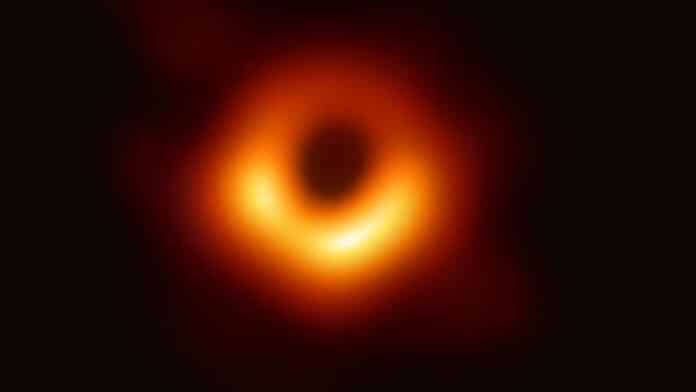The European Southern Observatory announced earlier this week that they have some big news to share. The international collaboration, Event Horizon Telescope (EHT) project, is ready to share their first results.
The EHT project has invested a very long time on a particular mission: to capture pictures of the immediate environment of the supermassive black hole Sagittarius A*, which is at the center of the Milky Way.
This breakthrough was announced today in a series of six papers published in a special issue of The Astrophysical Journal Letters. The image reveals the black hole at the center of Messier 87, a massive galaxy in the nearby Virgo galaxy cluster. This black hole resides 55 million light-years from Earth and has a mass 6.5 billion times that of the Sun.
EHT project director Sheperd S. Doeleman of the Center for Astrophysics | Harvard & Smithsonian said, “We have taken the first picture of a black hole. This is an extraordinary scientific feat accomplished by a team of more than 200 researchers.”
Black holes are some of the strangest and most fascinating objects found in outer space. They are objects of extreme density, with such strong gravitational attraction that even light cannot escape from their grasp if it comes near enough. The presence of these objects affects their environment in extreme ways, warping spacetime and super-heating any surrounding material.
Chair of the EHT Science Council Heino Falcke of Radboud University, the Netherlands, said, “If immersed in a bright region, like a disc of glowing gas, we expect a black hole to create a dark region similar to a shadow — something predicted by Einstein’s general relativity that we’ve never seen before. This shadow, caused by the gravitational bending and capture of light by the event horizon, revealed a lot about the nature of these fascinating objects and allowed us to measure the enormous mass of M87’s black hole.”
“Multiple calibrations and imaging methods have revealed a ring-like structure with a dark central region — the black hole’s shadow — that persisted over multiple independent EHT observations.”
Paul T.P. Ho, EHT Board member and Director of the East Asian Observatory said, “Once we were sure we had imaged the shadow, we could compare our observations to extensive computer models that include the physics of warped space, superheated matter, and strong magnetic fields. Many of the features of the observed image match our theoretical understanding surprisingly well. This makes us confident about the interpretation of our observations, including our estimation of the black hole’s mass.”
Supermassive black holes are relatively tiny astronomical objects — which has made them impossible to directly observe until now. As a black hole’s size is proportional to its mass, the more massive a black hole, the larger the shadow. Thanks to its enormous mass and relative proximity, M87’s black hole was predicted to be one of the largest viewable from Earth — making it a perfect target for the EHT.
For this observation, EHT uses a technique named very-long-baseline interferometry (VLBI) that synchronizes telescope offices around the globe and endeavors the revolution of our planet to form one huge, Earth-size telescope observing at a wavelength of 1.3 mm.
This technique allows the EHT to achieve an angular resolution of 20 micro-arcseconds—enough to read a newspaper in New York from a sidewalk café in Paris.
One of these telescopes was the South Pole Telescope, one of the most sensitive instruments in the world built to search for the oldest light in the universe. Operated by an international collaboration led by the University of Chicago, the South Pole Telescope helped calibrate the data from all telescopes and is key to expanding the EHT’s reach around the globe.
Doeleman said, “We have achieved something presumed to be impossible just a generation ago. Breakthroughs in technology, connections between the world’s best radio observatories, and innovative algorithms all came together to open an entirely new window on black holes and the event horizon.”
The telescopes contributing to this result were ALMA, APEX, the IRAM 30-meter telescope, the James Clerk Maxwell Telescope, the Large Millimeter Telescope Alfonso Serrano, the Submillimeter Array, the Submillimeter Telescope, and the South Pole Telescope [7]. Petabytes of raw data from the telescopes were combined by highly specialized supercomputers hosted by the Max Planck Institute for Radio Astronomy and MIT Haystack Observatory.
The construction of the EHT and the observations announced today represent the culmination of decades of observational, technical, and theoretical work. This example of global teamwork required close collaboration by researchers from around the world. Thirteen partner institutions worked together to create the EHT, using both pre-existing infrastructure and support from a variety of agencies. Key funding was provided by the US National Science Foundation (NSF), the EU’s European Research Council (ERC), and funding agencies in East Asia.
The EHT collaboration involves more than 200 researchers from Africa, Asia, Europe, North and South America. The international collaboration is working to capture the most detailed black hole images ever by creating a virtual Earth-sized telescope. Supported by considerable international investment, the EHT links existing telescopes using novel systems — creating a fundamentally new instrument with the highest angular resolving power that has yet been achieved.
This research was presented in a series of six papers published today in a special issue of The Astrophysical Journal Letters, along with a Focus Issue:
Paper I: The Shadow of the Supermassive Black Hole
Paper II: Array and Instrumentation
Paper III: Data processing and Calibration
Paper IV: Imaging the Central Supermassive Black Hole
Paper V: Physical Origin of the Asymmetric Ring
Paper VI: The Shadow and Mass of the Central Black Hole
